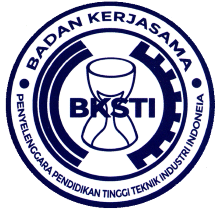Analisis Produktivitas Dengan Menggunakan Pendekatan Metode Objective Matrix (OMAX) Studi Kasus di PT. XYZ
(1) Teknik Industri, Universitas Indraprasta PGRI
(*) Corresponding Author
Abstract
A company organization needs to know the level of productivity where the company operates, in comparison with the productivity standards set by management. Productivity measurement using the OMAX method is a combination of several measures of productivity criteria that have been weighted according to the degree of importance of each size. The results of the calculation of the overall productivity value for 12 (twelve) months are as follows 57, 123, 57, 55, 130, 45, 112, 140, 140, 152, 118 and 145. The results of the calculation of the ratio of less value contribute to the increase production line productivity and needs to be improved because it shows sub-standard performance, namely ratio 1, 2, and 5. The value of ratios 3, 4 and 6 shows the ratio values that tend to be good. Based on the results of this study, the measurement of productivity using the OMAX method is very systematic and effective because it is built from critical factors in the company (productivity criteria) by prioritizing improvements in the value of ratios that have below standard values, and maintain good ratio values.
Keywords: productivity, measurement, objective matrix (omax), ratio.
Full Text:
PDF (Indonesian)References
Hamidah, N. H., Deoranto, P., & Astuti, R. (2013). Productivity Analysis Using Objective Matrix
(OMAX) Method: Case Study On The Production Departement of Sari Roti PT Nippon Indosari
Corpindo, Tbk Pasuruan. Jurnal Teknologi Pertanian, 14(3).
Herjanto, E. (2007). Manajemen Operasi (Edisi 3). Grasindo.
Kusmindari, D., & Aprianto, A. (2009). Produktivitas dan Pengukuran Kerja Proses Produksi
Medium Dencity Fibreboard (MDF). Jurnal Ilmiah Tekno, 6(2), 85-96.
Leonard, K., & Wahyu, M. (2010). Analisa Produktivitas dengan Metode Objective Matrix (OMAX)
pada Bagian Produksi Potong (Cutting) PT X. Jurnal Metris, 1(1), 41-48.
DOI: http://dx.doi.org/10.30998/joti.v1i1.3423
Refbacks
- There are currently no refbacks.









